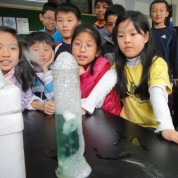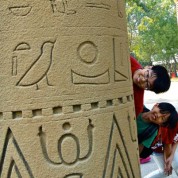Can you name the 4 great inventions of ancient China?
Today, we went on a fascinating field trip to the Beijing Science and Technology Museum. We visited the Chinese Legacies Exhibit. We were looking for the 4 great inventions of ancient China: paper gunpowder compass printing We learned so much more! There were wonderful models, moving machines and hands-on activities. We all practiced an ancient printing technique. We also learned about how the stars were observed, how time was kept, ancient medicines, water power, trade routes, weaving machines, farming tools and iron casting. Wow! The ancient Chinese people were very advanced! Take a look at our learning experiences: Ancient Chinese Legacies on PhotoPeach What did you find most interesting? Why? What did you learn about Ancient China that you didn’t know? Choose one legacy. Explain why it was important to ancient people. Now explain why it is still important...
Read MoreHalloween? We call it Science!
Today, we had a very exciting interruption to our day! Mrs Trussler, the Secondary School Science teacher, told us that a delivery of dry ice had arrived at school. How exciting! We raced upstairs to the Science lab for a wonderful lesson on states of matter. We watched in awe as the dry ice behaved differently in the air, on the table, in water and in a soap mixture. We learned that dry ice is actually solid carbon dioxide, which has frozen at a temperature of -78 degrees Celsius. We learned about solids, liquids and gases. We even watched the process of sublimination right before our eyes. We loved popping bubbles of carbon dioxide! Dry ice makes spooky smoke at Halloweeen….but today, it was Super Science for Grade 4! Thank you, Mrs Trussler, for adding so much to our learning. Halloween Science on PhotoPeach What did you learn about states of matter? What other substances do you know that change from a solid to a liquid to a gas? Can you explain sublimination?...
Read MoreDescribe the future in 100 words.
As we study ancient history, we have taken the opportunity to review concepts of past, present and future. While we research the lives of ancient people, we’ve also had fun imagining the lives of future generations. Our creative writing prompt this week came from the City Kids & Parents Magazine. What will the world be like in 100 years? Here are a few of our 100-word descriptions: 100 Years in the Future Now, let’s narrow our thinking to the next decade: What do you hope your life will be like in 10 years? What do you think the environment will be like in 10 years? What will you do to make the world a better place over the next decade?...
Read MoreWandering through the Ancient World
Today, we left our classroom and wandered through the ancient world. (Well, almost!) We spent the day at World Park, hunting for ancient architecture. With a map and a team, we navigated our way through ancient China, Rome, Egypt and Greece. We found, touched and climbed on replicas of many famous buildings. Our favorites were the pyramids, the Parthenon, the Colosseum and the Trojan Horse. We made notes about interesting features and discussed the ratio of size between the replica and the real buildling. We have learned that architectural legacies can be seen in many modern buildings. Ancient Architecture on PhotoPeach Keep reading and thinking: Have you seen any modern buildings with Greek columns? Why was the Trojan Horse built? How and why did the Egyptians build...
Read MoreGeometry Hunters: Ancient Greek legacies in our school!
Did you know that the ancient Greeks made lots of mathematical discoveries? This week, we have been looking at ancient architecture and learning about lines, angles and 2D shapes. We still use ancient Greek geometry in our art, architecture, music and games today. In small groups, we hunted for geometry around our school. We earned a point for every mathematical legacy we could find, name and measure. Here is a group of Geometry Hunters and their findings: What did you learn about the properties of 2D shapes this week? Why is mathematics important in architecture? Why is mathematics important in...
Read More






